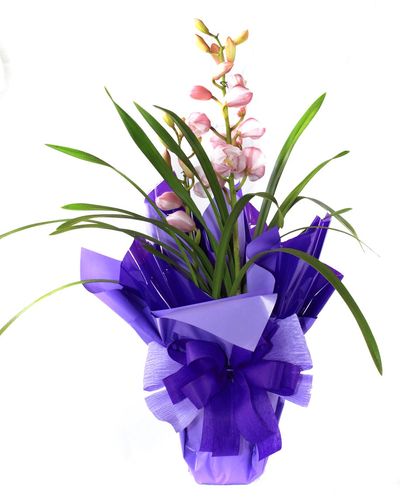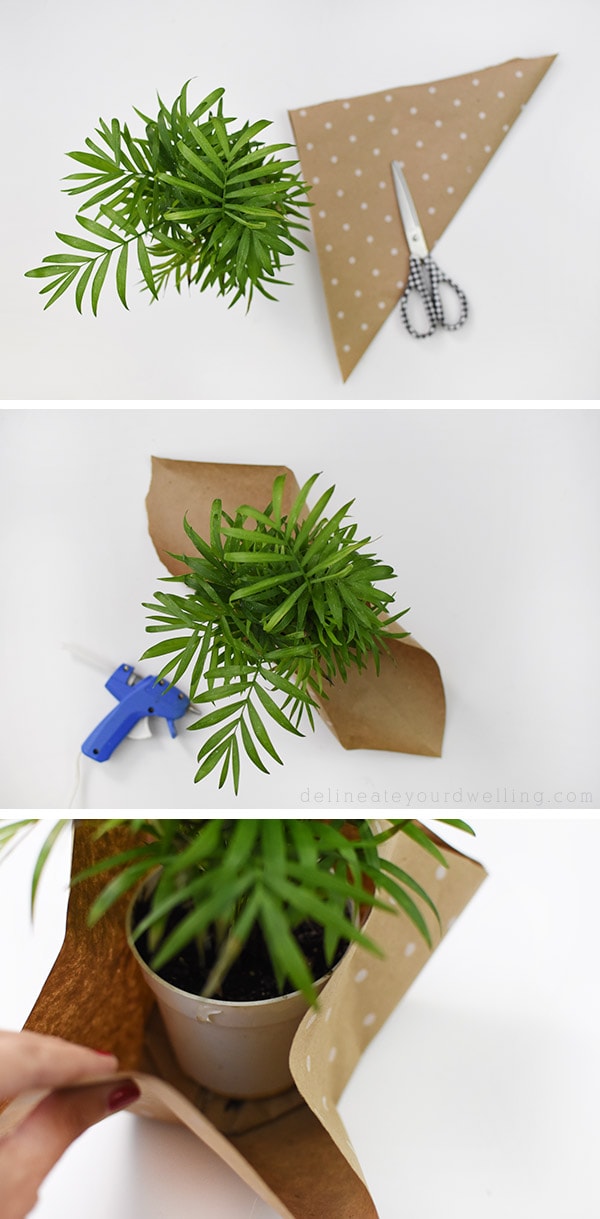To wrap a pot plant, first ensure the plant is secure in its pot, then gently wrap the pot with burlap or brown paper, tying it securely with twine or ribbon. Introducing a pot plant to your home or office can enhance the aesthetic appeal of any space.
However, it’s essential to protect the delicate plant during transportation or when moving it from one location to another. Wrapping the pot plant is a simple and effective way to keep it safe and secure. By following a few easy steps, you can ensure that your pot plant remains intact throughout the process.

Credit: www.gardeningknowhow.com
We will discuss the proper technique for wrapping a pot plant, allowing you to transport it or gift it with ease and confidence.
Choosing The Right Materials For Wrapping A Pot Plant
When wrapping a pot plant, it is important to consider the selection of materials carefully. Different materials offer different benefits and can enhance the overall presentation and protection of the plant. Here are various materials to consider:
| Material | Advantages |
|---|---|
| Plastic wrap | Provides a transparent barrier against moisture, protecting the pot plant from water damage. It is lightweight and cost-effective. |
| Kraft paper | Offers a natural and eco-friendly option. It provides moderate protection against moisture and can be customized with designs or labeling. |
| Jute fabric | Provides a rustic and natural look, perfect for eco-conscious individuals. It offers breathability and is biodegradable. |
Factors to consider when selecting wrapping materials include the level of protection needed, the desired aesthetic, and whether the material aligns with sustainability goals. By carefully choosing the appropriate material, you can enhance the overall appearance and protection of your pot plant.
How to Wrap Pot Plant : Step by Step Guide
To wrap a pot plant securely, start by preparing the plant properly. Gently remove any dead or damaged leaves and make sure the plant is clean. Next, choose a wrapping material that is suitable for your plant. This could be burlap, twine, or even a decorative fabric. Cut the material into a size that will cover the pot and leave enough excess to tie or secure it in place.
Once you have your material ready, carefully wrap it around the pot, making sure it is snug but not too tight. Use your hands or a pair of scissors to hold the material in place as you wrap it around. If needed, you can also use additional tape or string to secure the wrapping material.
Finally, make sure the wrapping is secure and won’t unravel easily. Double-check all the knots and ties to ensure the wrapping will stay in place. If desired, you can also add some decorative elements such as ribbons or bows to enhance the overall look of the wrapped pot plant.
Tips For Protecting Pot Plants During Transport Or Shipping
Transporting or shipping pot plants can be a delicate process that requires special attention to protect the plants and ensure they arrive at their destination in good condition. Here are some essential tips to secure the wrapped pot plant for transportation and prevent any damage:
1. Choose Appropriate Wrapping Material
Opt for a strong and durable wrapping material, such as bubble wrap or foam sheets, to provide cushioning and protect the pot plant from external pressures during transport.
2. Secure The Pot Plant With Tape Or Bands
Use strong adhesive tape or bands to wrap around the pot and secure it tightly. This will prevent the plant from moving around and getting damaged during transportation.
3. Add Extra Padding
If the pot plant has delicate leaves or branches, consider adding extra padding, such as tissue paper or newspaper, around them to provide additional protection.
4. Use Boxes Or Crates
Place the wrapped pot plant in a sturdy box or crate to provide further stability and protection during shipping. Make sure the box is properly labeled and marked as fragile to ensure careful handling.
By following these tips, you can ensure that your pot plants are well-protected during transport or shipping, allowing them to arrive at their destination in good condition.
Potential Challenges And Troubleshooting When Wrapping Pot Plants
Pot plants come in a variety of sizes and shapes, which can pose potential challenges when it comes to wrapping them. Dealing with larger or irregularly shaped pot plants requires special attention to ensure a proper fit. Addressing this issue starts with choosing the right wrapping material. Opt for a flexible and stretchable material that can easily adjust to the shape of the pot plant.
When wrapping larger pot plants, it may be necessary to secure the wrapping material in multiple layers to provide added support and protection. This will help prevent any potential damage during transport or storage.
Solving problems with wrapping techniques involves using proper folding and tucking methods to ensure a tight and secure wrap. Start by folding the wrapping material over the top of the pot plant and tuck it underneath securely. Repeat this process on opposite sides until the pot plant is fully wrapped.
Remember to secure the wrapping material with tape or rubber bands to keep it in place. This will prevent the material from unraveling and provide additional stability during handling.
Creative And Aesthetic Ideas For Pot Plant Wrapping Designs
When it comes to wrapping pot plants, there are countless creative and aesthetic ideas that can make your plants stand out. Incorporating decorative elements into the wrapping can elevate the overall presentation. Adding bows, ribbons, or even small ornaments can create a visually appealing design.
Experimenting with different colors and patterns can also make the wrapping more attractive. Think about using vibrant colors for a pop of excitement or soft pastel shades for a delicate touch. Patterns like stripes, polka dots, or floral prints can add a playful or elegant feel to the design.
Additionally, don’t be afraid to explore alternative wrapping techniques. Instead of traditional paper wrapping, consider using burlap, fabric, or even recycled materials for an unconventional and eco-friendly approach. By thinking outside the box, you can wrap your pot plants in a way that reflects your personal style and enhances their overall aesthetic appeal.
Enhancing Plant Care While Wrapping Pot Plants
Providing ventilation and moisture control is essential when wrapping pot plants. It is important to avoid overwrapping and suffocating the plant while still maintaining a balance between aesthetics and the plant’s health and well-being.
- Ensure proper airflow: Use breathable materials like burlap or fabric that allow air circulation around the plant.
- Use adequate wrapping: Avoid excessive wrapping that can block sunlight and hinder photosynthesis. Wrap only the pot and leave the foliage exposed.
- Prevent moisture buildup: Wrap the pot in a way that allows excess water to drain properly and prevents waterlogging that can lead to root rot.
- Consider the plant’s needs: Different plants have different requirements, so choose a wrapping method that suits your plant’s specific needs.
- Monitor plant health: Regularly check for signs of stress, such as yellowing leaves or wilting, which may indicate issues with wrapping.
By adopting these practices, you can ensure that your pot plants thrive and stay healthy while they are beautifully wrapped.
Eco-friendly Alternatives For Wrapping Pot Plants
When wrapping pot plants, it is essential to consider the environmental impact and opt for sustainable and recyclable materials. By utilizing reusable options, you can not only minimize waste but also maintain an attractive presentation.
One eco-friendly alternative is to use biodegradable burlap or jute fabric, which can be easily wrapped around the pot and secured with eco-friendly twine. These materials are not only environmentally friendly but also provide a rustic and natural look.
Another option is to reuse newspaper or old book pages, which can be folded into attractive wrapping paper. Alternatively, you can wrap the pot using a piece of furoshiki cloth, a traditional Japanese wrapping cloth that can be used repeatedly for different purposes.
If you are looking for something more customizable, consider fabric pot covers or reusable fabric wraps. These options allow you to change the wrapping design as frequently as you like without generating unnecessary waste.
Remember, going eco-friendly does not mean compromising on presentation. By utilizing sustainable and recyclable materials, you can wrap your pot plants in an environmentally responsible way while still creating an aesthetically pleasing display.
Maintaining The Wrapped Pot Plant For Longevity
The key to maintaining the longevity of a wrapped pot plant lies in regularly checking and adjusting the wrapping. By ensuring that the wrapping is secure and snug, you can protect the plant from potential damage caused by shifting or exposure to the elements.
It is important to monitor the plant’s health and respond promptly to any issues that may arise. This includes checking for wilting, discoloration, or signs of pests, and taking appropriate action to address these concerns. Additionally, proper watering and fertilization should be done as per the plant’s needs. By taking these steps, you can ensure that the wrapped pot plant remains healthy and vibrant for an extended period of time, enhancing both its longevity and aesthetic appeal.
Frequently Asked Questions For How To Wrap Pot Plant
How Do You Wrap An Empty Pot?
To wrap an empty pot, start by covering the bottom with bubble wrap or a cloth. Then, wrap the pot’s sides tightly with additional bubble wrap or paper. Secure the wrapping with tape and add extra padding or newspaper to protect the pot during transportation or storage.
How Do You Wrap A Plant Pot In Burlap?
To wrap a plant pot in burlap, start by measuring the height and circumference of the pot. Next, cut a piece of burlap fabric to fit these measurements. Then, wrap the burlap around the pot, securing it with twine or glue.
Finally, trim any excess burlap if needed.
How Do You Wrap A Plant In Foil?
To wrap a plant in foil, first ensure it is not wet. Take a piece of foil larger than the plant’s size. Gently wrap the foil around the base, ensuring the plant is secure. Leave the top open for airflow.
Cover exposed soil with plastic wrap to retain moisture.
How Do You Wrap A Pot Plant Without Damaging It?
To wrap a pot plant without damaging it, start by gently securing the leaves and branches with twine or plant ties. Next, wrap the entire pot and plant in burlap or a protective material. Secure the wrapping with tape or ribbon, making sure it’s snug but not too tight.
This will help protect the plant during transport or harsh weather conditions.
Conclusion
Wrapping a pot plant may seem like a simple task, but it’s essential for protecting your plant from harsh weather conditions and pests. By following the steps outlined in this post, you can ensure that your pot plant stays healthy and vibrant.
Remember to choose the right materials, wrap the plant snugly but not too tightly, and provide proper ventilation. With these tips, you’ll be able to maintain the well-being of your pot plant and enjoy its beauty for years to come.
Happy wrapping!

